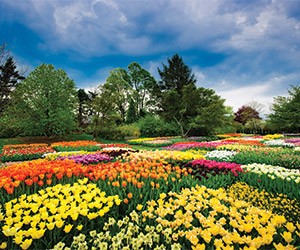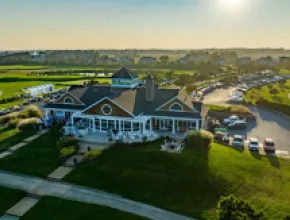America may be missing monarchs in its heritage, but there are a few places where the wealthy have left us some royal sites and high-brow culture. One such culture corridor is Delaware’s Greater Wilmington and Brandywine Valley region—a treasure trove of other-era opulence and natural beauty.
The region’s proximity to New York, Philadelphia and Washington, D.C., gives it easy East Coast accessibility to a major population mass near and far. Yet it also delivers a serene, leafy and sometimes unexpected out-in-nature alternative to the city scene. And for added group appeal, Delaware’s tax-free status frequently gives groups welcome budget-friendly surprises.
"We are truly the great alternative to the larger cities—not only for easy access, but for our no-tax status," says Esther Lovlie, director of sales and marketing for meetings, events and group tours for the Greater Wilmington CVB. "We are new on the radar of some planners, primarily because we don’t have big-city tourism dollars to put ourselves out there. But once they get here and learn about our unique attractions and easy accessibility, they are convinced."
Philadelphia International Airport is only 25 minutes from Wilmington, and Interstate 95 runs through the middle of the city. Amtrak train service has many frequent daily trips in and out of the city.
Wilmington has the larger meeting facilities and other magnets of urban sophistication along with riverfront ambience. The nearby valley combines smaller group facilities and stunning cultural attractions rooted in the du Pont family legacy.
New Downtown
Downtown Wilmington is a business-centric district with many Fortune 500 names on core buildings. The state’s tax status is one reason they’re there, and meeting planners can tap into the same perks, while attendees enjoy the no-tax feature when shopping or dining out.
To sweeten the deal this year, the Greater Wilmington CVB is offering a Transportation Incentive for meetings and events. The incentive is provided by a grant from the Delaware Tourism Office and the GWCVB partnership with the city of Wilmington, the Riverfront Development Corporation and Wilmington Renaissance Corporation. Events must be booked by July 30, and depending on the number of room nights, groups can receive between $2,600 and $20,000 in transportation assistance.
Meanwhile, an array of fine and casual dining restaurants is also part of center city, along with clubs and arts venues. The Riverfront Market is a bustling public emporium housed in a historic warehouse where visitors enjoy local produce, meats and international taste treats.
One of the city’s most exciting new additions, the DuPont Environmental Education Center, has a location on the edge of the city and next to the 212-acre Russell W. Peterson Urban Wildlife Refuge. With 13,500 square feet of space, the center has meeting space for up to 80 attendees and offers a panorama of the tidal marsh where eagles soar and ospreys nest. The marsh has been reclaimed and transformed into a thriving ecosystem that now supports more than 200 species of wildlife.
Also new along the downtown riverfront is the Delaware Children’s Museum. It features 37,000 square feet of interactive fun and a large outdoor deck that overlooks the Christine River, a great setting for summer events and gatherings.
Queen Theatre is a 1915 building that was once the toast of the town with a balcony that seated 2,000 people. It is undergoing a renovation, with an opening expected early next year of what will be a live music venue, restaurant, broadcast studio and event complex showcasing performers across the musical spectrum.
Wilmington’s new additions are near major meeting facilities like The Chase Center on the Riverfront, where more than 87,000 square feet of space can accommodate up to 1,600 people. Within two miles of the Chase Center are 800 guest rooms in properties like the historic Hotel du Pont, Doubletree Hotel Downtown Wilmington and Sheraton Suites Wilmington.
America’s Loire Valley
The du Pont family’s connections to France are easy to see in the castle-like estate homes they built in the Brandywine Valley. The original du Pont emigrant came to America in 1800 and launched a corporate empire on the banks of the Brandywine River. Later generations added palatial homes and elegant gardens along leafy, winding Route 52 out of the city. Most accommodate private events.
The corporate story began with the manufacture of gunpowder in 1802. The early days are chronicled in the family’s original home and museum at the 230-acre Hagley Museum & Library site on the river.
Cher L. Przelomski, CEO of Planning Factory International in Wilmington, says one of her favorite valley event venues is the Hagley Soda House on the Hagley museum grounds.
"It’s an older property they have updated with a facade of glass and stone, audiovisual facilities and so on," says Przelomski. "It’s popular for both meetings and social events, really a nice tranquil property on the river."
Winterthur Museum & Country Estate is a 966-acre property created by Henry Francis du Pont. The 175-room mansion and 60 acres of gardens present a premier collection of early American decorative arts in rooms filled with art and artifacts.
Longwood Gardens, Pierre du Point’s 1,000-acre horticultural extravaganza, has thousands of plant and tree varieties that attract a million visitors a year. Several dramatic venues within the gardens are available for private events.
Nemours is the dazzling Alfred I. du Pont French-style estate, which recently reopened after a $39 million restoration. The 1910 property contains many original furnishings and works by artists like Charles Wilson Peale and Frederick Remington. Alfred’s personal collection of restored Rolls Royces and other vintage cars are in the chauffeur’s garage.
The Brandywine River Museum in Chadds Ford is famed for its collection of Wyeth family art from three generations, including works of N.C., Andrew, Jamie, Betsy, Caroline and husband Peter Hurd. The collection has grown from 21 pieces in 1971 to more than 3,000 works—many of them Wyeth paintings. N.C. Wyeth’s House and Studio and the Kuerner Farm, made famous through nearly 1,000 of Andrew’s works, are pieces of this cultural stop.
Board and other small meetings groups frequently take up valley residence at the elegant Inn at Montchanin Village, itself a transformed historic site.
Comprising 28 suites with modern appointments like marble baths, guest accommodations reside in former transformed homes of du Pont company mill workers and farm buildings from the late 19th and early 20th centuries. Meeting spaces include the Dilwyne Barn Conference Room for up to 40 people. Krazy Kats Restaurant occupies the former blacksmith’s shop and features private dining spaces. Guests can relax at the inn’s new spa.
Whether groups establish downtown or in the valley, they can easily experience the Brandywine Valley Wine Trail, which features eight wineries and estate vineyards that present picturesque tasting rooms and barrel-filled cellars. Cornucopia Tours is one vendor that offers customized tours promoting the valley area and the du Pont legacy. Services range from escorted tours for individuals and small groups to step-on guides for larger tours.
Excursions to Historic New Castle, colonist William Penn’s 1682 landing site in the New World, put groups in a cobblestoned living history museum of the 17th and 18th centuries. Restored homes from the first three centuries of the region’s settlement are open for inspection. Groups can stay and meet at the Doubletree New Castle, with its 20,000 square feet of meeting space, and the Clarion-Hotel-The Belle, featuring a 6,050-square-foot ballroom.
Just 23 miles south of Wilmington are the Historic Houses of Odessa, a collection
of 18th and 19th century homes that contain authentic period furnishings, many of which were crafted by 18th century Delaware cabinetmakers, silversmiths and painters.






